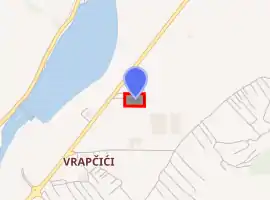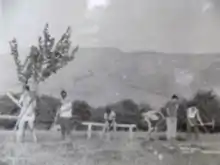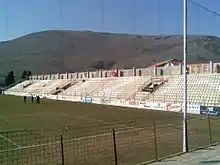Stadion Rođeni
Stadion Rođeni (English: Rođeni Stadium), previously known as Stadion Vrapčići (English: Vrapčići Stadium), is FK Velež Mostar owned football stadium in Mostar, Bosnia and Herzegovina, which is in slow process of development since 1995.[3][4] It is located in the northeastern part of the city, namely the Vrapčići suburb, and is principal stadium and the home-ground of FK Velež Mostar football club. The stadium takes its name from FK Velež's and its supporters' nickname "Rođeni" (English: "own", as in "our own"; literally "born"), and it was decided after an online poll.
 | |

| |
| Former names | Stadion Vrapčići (1995–2017) |
|---|---|
| Location | Mostar, Bosnia and Herzegovina |
| Coordinates | 43°22′42″N 17°51′16″E |
| Owner | City of Mostar |
| Capacity | 7,000[1] |
| Field size | 105 x 68 m |
| Surface | Grass |
| Construction | |
| Built | 1995 |
| Opened | 25 November 1995[2] |
| Renovated | 2008 |
| Expanded | 2006, 2020 |
| Tenants | |
| FK Velež Mostar (1995–present) | |
History

The first attempt to build a stadium happened at the beginning of 1938. FK Velež management decided to call a loan among the club's supporters and friends, and all Mostar's working class, whose money would be used to buy land and build a playground. A non-interest-bearing loan, with a two-year repayment period after the construction of the playground, was proposed, and coupons called "Loan" were issued in denominations of 50 and 100 dinars. In this way, 100,000 dinars were collected. When an agreement was reached on the purchase of land, the club was banned by the regime on 3 September 1940, and the money collected was than directed to humanitarian cause "Red Assistance".
After the World War II stadium Pod Bijelim Brijegom was built through volunteer labor of young people from Mostar and Bosnia and Herzegovina, between 1947 and 1958.
The club currently plays at the Rođeni Stadium, but its historic stadium is the Bijeli Brijeg Stadium.[5] From time the Bosnian War broke out, and in particular subsequent incitement of Croat-Bosniak hostilities, conflicting ideologies and interests were conveyed from the war times into the post-war era, which continuously manifesting itself through steady political divisiveness in the city of Mostar, among other shown in issues of territorial and ownership disputes. Such political ambiance showed in the forced eviction of FK Velež Mostar from its traditional home-ground of Bijeli Brijeg, and in subsequent legal disputes over stadium usurpation by another club, emerging in the city at the time.
Bijeli Brijeg was a stadium used by FK Velež Mostar from the time it was built until 1992, through the club's glory days, when they emerged triumphant from their campaigns in the 1980–81 and 1985–86 Yugoslav Cups competition, and before that when the club also reached the quarter-final stage of the 1974–75 UEFA Cup.[3]
New location, new facilities

The new location of the club's new stadium facilities is in the northeastern part of the city, namely the Vrapčići suburb. It is the principal stadium and the home-ground of FK Velež Mostar, and at present stage of development, it can receive up to 7,000 supporters in attendance.[1] The lack of funds and a slow process of country's recovery from the war, as well as complicated political ambient in the city and the country as a whole, all influenced the scope and the tempo of stadium development.
Velež returned to the top flight of Bosnia and Herzegovina football after being promoted in 2006. This return was accompanied with a construction of large northern and smaller eastern stand. In 2012, the eastern stand was renamed the Red Army Tribina (Red Army Stand) after Red Army Mostar, Velež's supporter group. In 2008, a large western stand was built, which was followed with additional works and expansions between 2017 and 2018. In 2019 a roof for the western stand was finished.[4][3]
While hosting a fundraiser for the club, the president of Velež, Šemsudin Hasić announced that within three years (2022 will be Velež's 100 year anniversary) the stadium would be upgraded to the point it could be known as the "Rođeni Arena".[6] One month later in December 2019, the eastern stand was demolished for a new stand to be built proportional to the northern stand, known by supporters as the Red Army..[7] The first official match played under the floodlights at Rođeni Stadium was on August 8, 2020, when Velež defeated Zrinjski 2:0 in the Mostar derby.
References
- "Stadion Rođeni (Stadion Gradski Vrapčići)". stadiumdb.com. Retrieved 9 May 2019.
- "Mjesto koje zovemo dom". telesport.telegram.hr. Retrieved 5 April 2020.
- "Velež treći put pravi stadion, prvi put vlastiti". Al Jazeera Balkans (in Bosnian). 4 November 2017. Retrieved 4 April 2019.
- "/ FK Velež ulaže u infrastrukturu: Stadion". Faktor.ba (in Bosnian). Retrieved 4 April 2019.
- "Hrvatski intelektualci poručuju: Vratite Veležu stadion, Mostar bez Rođenih pod Bijelim Brijegom nije Mostar". Tacno.net (in Serbo-Croatian). 17 March 2015. Retrieved 9 May 2019.
- "Kakva vijest za navijače Veleža: Rođeni grade 'Arenu' u naredne tri godine". sport1.ba (in Bosnian). Retrieved 7 March 2020.
- "(FOTO) Nema više tribine na kojoj je bio smješten Red Army, nići će potpuno nova na istom mjestu". sport1.ba (in Bosnian). Retrieved 7 March 2020.
External links
| Wikimedia Commons has media related to Stadion Rođeni. |
- FK Velež Mostar Official website (in Bosnian)
- UG Mostarski Rođeni (in Bosnian)